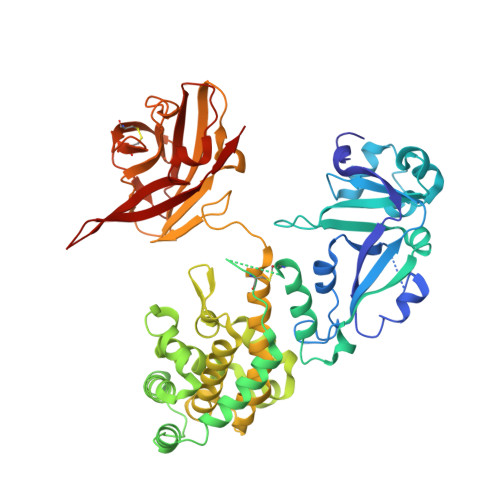Structural and immunological characterization of E. coli derived recombinant CRM 197 protein used as carrier in conjugate vaccines.
Mishra, R.P.N., Yadav, R.S.P., Jones, C., Nocadello, S., Minasov, G., Shuvalova, L.A., Anderson, W.F., Goel, A.(2018) Biosci Rep 38
- PubMed: 29875175
- DOI: https://doi.org/10.1042/BSR20180238
- Primary Citation of Related Structures:
5I82 - PubMed Abstract:
It is established that the immunogenicity of polysaccharides is enhanced by coupling them to carrier proteins. Cross reacting material (CRM 197 ), a nontoxic variant of diphtheria toxin (DT) is widely used carrier protein for polysaccharide conjugate vaccines. Conventionally, CRM 197 is isolated by fermentation of Corynebacterium diphtheriae C7 (β 197 ) cultures, which often suffers from low yield. Recently, several recombinant approaches have been reported with robust processes and higher yields, which will improve the affordability of CRM 197 -based vaccines. Vaccine manufacturers require detailed analytical information to ensure that the CRM 197 meets quality standards and regulatory requirements. In the present manuscript we have described detailed structural characteristics of Escherichia coli based recombinant CRM 197 (rCRM 197 ) carrier protein. The crystal structure of the E. coli based rCRM 197 was found to be identical with the reported crystal structure of the C7 CRM 197 produced in C. diphtheriae C7 strain (Protein Data Bank (PDB) ID: 4EA0) . The crystal structure of rCRM 197 was determined at 2.3 Å resolution and structure was submitted to the PDB with accession number ID 5I82. This is the first report of a crystal structure of E. coli derived recombinant CRM 197 carrier protein. Furthermore, the rCRM 197 was conjugated to Vi polysaccharide to generate Typhoid conjugate vaccine (Vi-rCRM 197 ) and its immunogenicity was evaluated in Balb/C Mice. The Vi-rCRM 197 conjugate vaccine was found to generate strong primary α-Vi antibody response and also showed a booster response after subsequent vaccination in mice. Overall data suggest that E. coli based recombinant CRM 197 exhibits structural and immunological similarity with the C7 CRM 197 and can be used as a carrier protein in conjugate vaccine development.
Organizational Affiliation:
Biological E. Limited, Genome Valley, MN Park, Shameerpet, Hyderabad 500078, India.
















